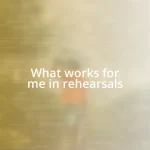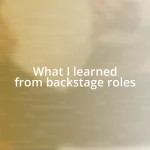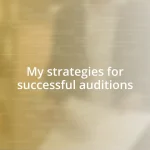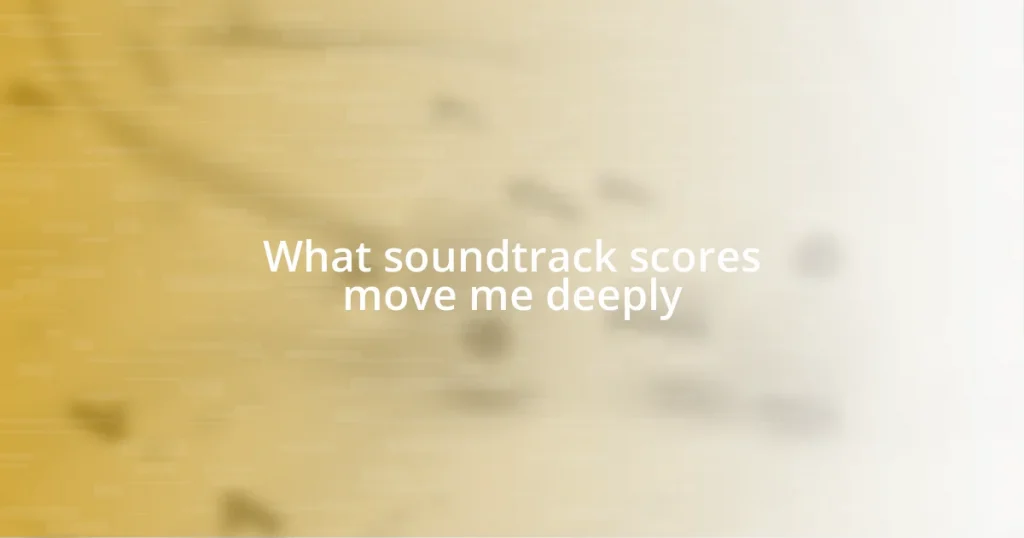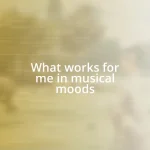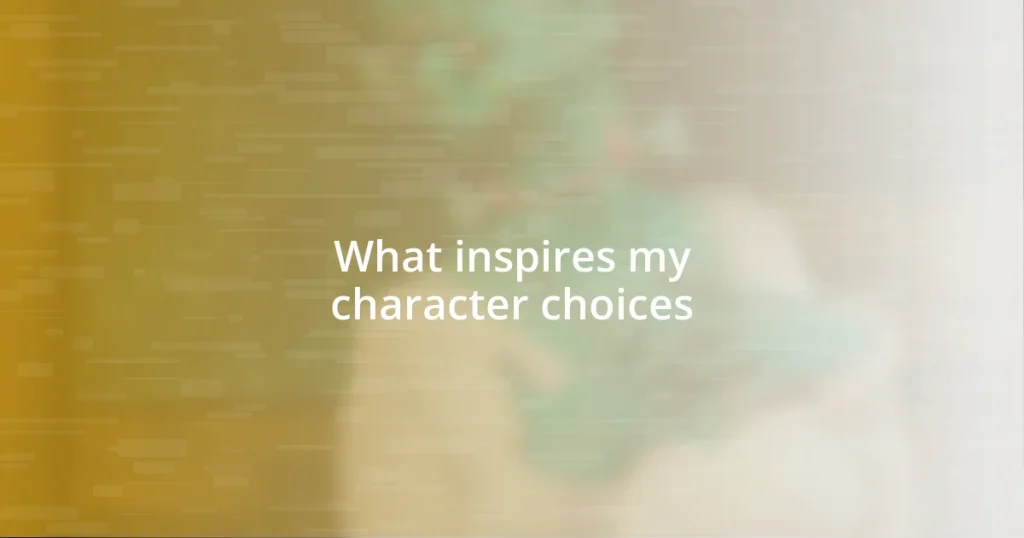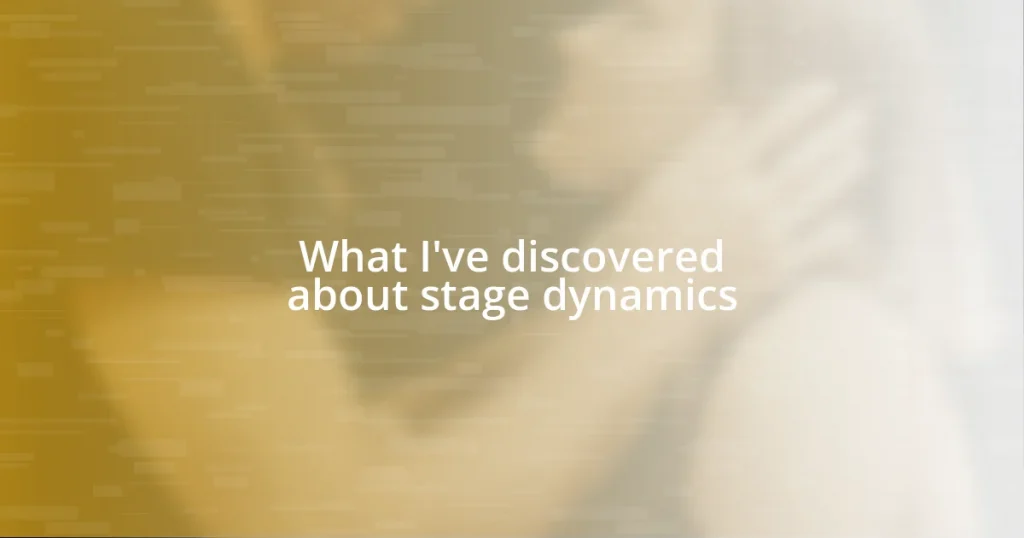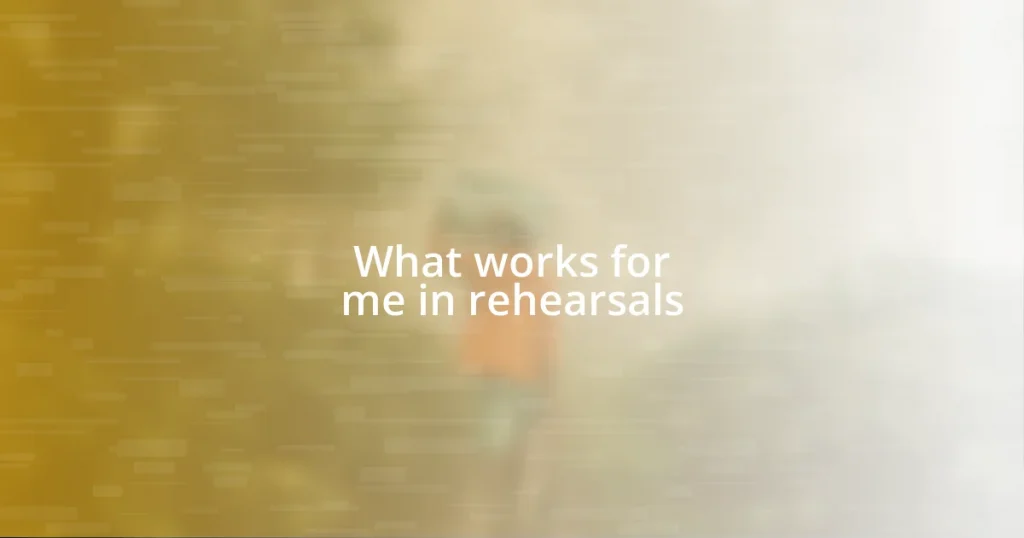Key takeaways:
- Music evokes deep, personal emotions and memories, often connecting listeners to pivotal moments in their lives.
- Key elements of a moving soundtrack include harmonic progressions, instrumentation, and tempo, which shape emotional responses.
- Creating an emotional playlist allows for a personal reflection on significant life moments, enhancing the connection to one’s experiences through diverse musical styles.

Understanding music’s emotional impact
Music has a unique ability to tap into our emotions, often evoking feelings we may not even be aware of. There have been moments when a simple melody brought me back to a forgotten memory, triggering emotions that were dormant for years. Have you ever listened to a song and felt as if it was narrating your own life story?
When I hear a poignant soundtrack, like the one from my favorite film, I’m often enveloped in nostalgia, which reminds me of specific times and places. These pieces resonate deeply with our life experiences, connecting the listener not just to the music, but to the emotions tied to those moments. Think about it: how many times have you found yourself teary-eyed during a film, solely due to the heartfelt score?
The power of music lies in its ability to transcend words and communicate feelings directly to our hearts. Often, I’ve found that the orchestration—the rise and fall of strings, the soft chime of piano—creates a landscape of emotions that words simply cannot capture. This rich tapestry of sound invites listeners to explore the depths of their feelings and provides a safe space for vulnerability. What does your favorite soundtrack reveal about your emotional landscape?

Elements of a moving soundtrack
The elements of a moving soundtrack often revolve around harmonic progressions that speak to our soul. For instance, I remember the first time I heard a score that utilized minor chords effectively; it transformed the atmosphere entirely, enveloping me in a shroud of melancholy and wonder. It’s fascinating how a simple shift from a major to a minor key can invoke such deep emotional responses.
In addition to harmonic structure, instrumentation plays a crucial role. I often find that a solo instrument, like the haunting sound of a cello, can express loneliness and yearning in ways that a full orchestra may not. When a familiar piece begins with the gentle strumming of an acoustic guitar, I feel an immediate connection, as if the melodies are threading their way through my memories—each note reminding me of moments that shaped who I am.
Finally, tempo and dynamics can manipulate our emotions with expert precision. Take, for example, a soundtrack that starts slowly, building in intensity. I’ve experienced moments when the crescendo swept me off my feet, leaving my heart racing and breath caught. It’s that dramatic tension that draws listeners in, holding them captive until the final note. How do you experience these shifts in your favorite soundtracks?
| Element | Description |
|---|---|
| Harmonic progressions | Major/minor chords influence emotional tone. |
| Instrumentation | The choice of instruments conveys depth and feeling. |
| Tempo and dynamics | Shifts in pace and volume guide emotional arcs. |

Exploring personal connections to scores
There’s something uniquely personal about the way certain scores resonate with me. I remember the first time I heard the score for “Interstellar.” The blend of haunting organs and delicate strings pulled at my heart, reminding me of late-night conversations with my father about the cosmos. Each swell and drop in the music felt like a journey through our shared dreams, evoking a sense of longing that ran deep within.
- Moment of connection: Scores can take you back to pivotal moments in your life, making you relive emotions tied to those experiences.
- Triggering nostalgia: Hearing a particular piece might make you smile or cry, recalling forgotten joy or loss.
- Personal stories: Think of how a song can remind you of a loved one, encapsulating the essence of your relationship in a few notes.
I’ve often found that scores articulate unspoken feelings, bridging gaps where words fail. One day, while listening to the soundtrack from “The Pursuit of Happyness,” I felt an overwhelming sense of determination. The music conveyed hope and resilience, reflecting my own struggles during a challenging time in my life. It reminded me that the journey matters as much as the destination.
- Expressing the inexpressible: Scores often capture emotions that are complex and hard to articulate in words.
- Resonating with personal struggles: Music can reinforce our resolve, guiding us through tough times.
- Evoking shared experiences: Scores have a way of creating a collective experience, reflecting not just individual stories, but universal themes that bind us together.

Top films with powerful scores
Some films take their scores beyond mere background music— they create a full emotional landscape. Take The Lion King, for example. Hans Zimmer’s orchestration, paired with songs like “Circle of Life,” doesn’t just accompany the visuals; it elevates moments of joy and tragedy. The drums resonate like a heartbeat, and I find myself immersed, recalling childhood memories of watching the film with family, feeling that shared sense of wonder and loss.
Another gem is Gladiator. The score by Zimmer and Lisa Gerrard pulls me in from the start, with its rich blend of orchestral and vocal elements. When I hear “Now We Are Free,” I can almost feel the weight of Maximus’ journey and his yearning for freedom. It’s as if the music reflects not just his struggle, but my own moments of resilient hope amidst challenge. Have you ever felt that a score perfectly articulates your personal battles? That connection runs deep; it reminds me that we all face trials, and music can be a powerful companion on that journey.
Similarly, the score of Amélie by Yann Tiersen transports me to a whimsical realm where every note feels like a brushstroke painting the essence of life itself. I vividly remember listening to it on a rainy day, daydreaming about adventure and love, wrapping myself in the warmth of those melodies. Each whimsical pluck of the strings and poignant piano key sparked joy and nostalgia within me—making me wonder, isn’t it remarkable how sound can evoke such vivid imagery and feelings?

Techniques for deep listening
Engaging in deep listening requires a mindful approach that truly immerses me in the music. One technique I find valuable is creating a distraction-free space where I can focus solely on the sounds. I often dim the lights, close my eyes, and allow the music to wash over me. This practice helps me pick up on details I might miss in a noisy environment—like the subtle swell of a string section or the delicate interplay of instruments.
Another method I embrace is to visualize scenes or emotions that the music evokes. For instance, when I listen to the score of “The Secret Life of Walter Mitty,” I can almost visualize the vast landscapes and soaring adventures portrayed in the film. It encourages me to tap into my own dreams, igniting my imagination. Have you ever let the music guide your thoughts to unexpected places? It can be a transformative experience, guiding me to not just hear, but feel the narrative woven into the score.
Lastly, I’ve developed a habit of journaling my reactions after a deep listening session. Writing down my experiences helps me articulate what the music stirs within me. I remember one evening, captivated by the score of “Blade Runner 2049,” I poured my thoughts onto the page as the music created a haunting atmosphere. It’s fascinating how reflecting on these feelings can deepen my connection with the artwork. What insights might you find if you gave yourself the space to explore your emotions around a beloved score?

Creating your own emotional playlist
Curating your own emotional playlist is a deeply personal journey. I find that it helps to start with a theme that resonates with my soul—be it nostalgia, love, or resilience. For example, after a particularly tough week, I once created a playlist of songs that represent strength and perseverance. With tracks like “Fight Song” by Rachel Platten, each note seemed to remind me of my ability to overcome challenges, empowering me when I needed it most.
When selecting songs, I often reflect on significant moments in my life. Recently, I added “River Flows in You” by Yiruma to my playlist. The gentle, flowing piano evokes memories of quiet evenings spent contemplating my dreams. Every time it plays, I’m transported back to those introspective moments, feeling both peace and motivation. Can you recall a piece of music that just perfectly encapsulates a phase of your life? It’s like a soundtrack to our experiences, an ever-evolving chronicle of our emotions.
Lastly, don’t shy away from mixing genres or styles—diversity can evoke richer emotions. I remember feeling surprisingly uplifted by a classical piece followed by a rock anthem, like the juxtaposition between Beethoven and Imagine Dragons. It’s fascinating how each composition, with its unique vibe, carries a different emotional weight. Isn’t it interesting that a single playlist can take you on an entire emotional rollercoaster, reflecting the multifaceted nature of our lives? Your playlist can be a reflection of your journey, full of highs and lows, just like the soundtrack of a great film.


